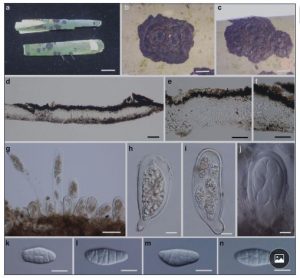Mendogia macrostroma D.Q. Dai & K.D. Hyde, sp. nov.
Index Fungorum number: IF552020
Etymology: In reference to it’s large stromata.
Holotype: MFLU 13–0642
Epiphytic on living bamboo culms. Sexual morph: Ascostromata 10–20 × 5–15 mm, 130–200 μm high, solitary, or gregarious up to 25 × 20 mm, superficial, round, elliptical to irregular, black, coriaceous, flattened, with central area slightly raised, and peripheral wall of stromata cracking, revealing the dark brown inner issue, pseudoparenchymatous tissue and asci growing under stroma, with irregular edge, rugose to rugulose at surface, multi-loculate, easily removable from the host. Surface cells of ascostromata 20–30 μm thick,composed of black tissue, easily breaking. Cells between asci 100–150 μm thick composed of large, hyaline, pseudoparenchymatous cells of textura angularis. Hamathecium with only asci; pseudoparaphyses not observed. Asci arranged in type II, 72–85 × 28–33.5 μm (x = 76.6 × 31.2 μm, n = 20), 8-spored, bitunicate, fissitunicate, subglobose to clavate, with rounded pedicel, with a distinct ocular chamber. Ascospores 20– 27 × 9–11 μm (x = 24.2 × 10.1 μm, n= 20), irregularly arranged, hyaline, ellipsoidal, with rounded ends, muriform, with 4–6 transverse septa and 2–4 longitudinal septa, constricted at the septa, smooth-walled, narrow at basal end, occasionally narrow at both ends. Asexual morph: Undetermined.
Material examined: THAILAND, Chiang Rai, Khun Korn Waterfall, on living culms of bamboo, 5 October 2012, Dong Qin Dai DDQ00255 (MFLU 13–0642, holotype); Ibid. (KUN HKAS88716, isotype); Ibid., August 2014, R. Phookamsak RP0134 (KUN HKAS83874).
Notes: Mendogia macrostroma differs morphologically from other species of Mendogia by its large ascostromata (10–20 × 8–15 mm vs. less than 4 mm diam.) and wider asci (28–33.5 μm vs. less than 25 μm) (Hennings 1904; Sydow and Sydow 1914a, 1917). The new taxon can be compared with Myriangium haraeanum F.L. Tai & C.T. Wei (synonym: Myriangium bambusae Hara 1913) in having dark, flattened ascostromata and muriform ascospores (Tai and Wei 1933; Eriksson and Yue 1998). However, the new species differs in having larger ascostromata (10–20 × 8–15 mm vs. 1– 3 mm in diam.). Moreover, Mendogia macrostroma has subglobose to clavate asci, whereas Myriangium haraeanum has cylindrical asci (Tai and Wei 1933).
FIG 1. Mendogia macrostroma (MFLU 13–0642, holotype). a Type material; b, c Black ascostromata on host; d Vertical section of ascostroma; e , f Surface cells of ascostromata and pseudoparenchymatous cells between asc; g–j Asci (g: Showingfissitunicate dehiscence); k–n Ascospores; Scale bars: a = 2 mm, b, c = 1 mm, d–g = 100 μm, h–j = 20 μm

